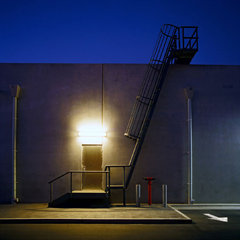Two exhibitions
dal 30/9/2008 al 31/10/2008
Segnalato da
30/9/2008
Two exhibitions
Stills Gallery, Sydney
Mark Kimber's latest body of work, continues his fascination with the borders of suburbia: carparks, industrial buildings, shadows and signs. Chris Fortescue has deployed a baffling array of sharply lit convoluted forms set against deep black backgrounds, which at first glance could be read as organic specimens or digital constructions.

Edgeland, Mark Kimber's latest body of work, continues his fascination with the borders of suburbia; carparks, industrial buildings, shadows and signs. In his earlier work SUN PICTURES (Stills Gallery, 2007) Kimber used a plastic 'Diana' camera to capture these scenes. The visual qualities that a rough plastic lens, two apertures (sunny and cloudy) and one shutter speed impart ably transformed objects and places into vignetted and illusionistic scenes.
Kimber is compelled to find "situations where the play of light, form and landscape converge in time and space to create an elusive and ephemeral piece of theatre." To produce EDGELAND he changed cameras, this time using a high definition model and shooting at dusk, the edge of the day. The intense colour of the twilight sky mixes with the artificial lights of the night. The car parks, containers and buildings become poetic summaries of themselves. The street and building lights that proliferate in his scenes are like beacons, calling our attention to details, which we would, in the bright light of day, disregard. Despite the lack of human actors, the lights suggest a stage waiting for the performers to return, with the sun.
In Truck Stop - South Road, a scene reminiscent of a Jeffrey Smart painting, the ghostly lines of a thousand truck tyres flow quietly in an arc under the sole street- light. In Back door - Mile end, a door seems to offer a range of possibilities for the next person to pass through it; a ladder to climb up, a white arrow to follow or - under the humming fluoro light - a podium on which to stand and ponder. In both of these works, a deep blue twilight sky hovers theatrically over the scene below. Like the American photographer Garry Winogrand, Kimber has always been fascinated with camera "sight", the marvellous alchemical process of shifting 3D matter into 2D imagery.
Mark Kimber is Head of Photography and New Media at the South Australian School of Art, University of South Australia. His work is held in various public and private collections including the National Gallery of Australia, Art Gallery of SA, Artbank, Art Gallery of WA, Parliament House collection, Waverley City Art Gallery, Albury Regional Gallery and the London Institute.
..............................
Chris Fortescue is more interested in dismantling the conventions of photographic depiction than partaking in them. In his 2007 exhibition at Stills Gallery Rectified Searches: Road, Chris, Fog, he directed our attention to the genetics of portrait and landscape imagery through reconfigured jpeg files retrieved from the internet using keyword searches. In his latest body of work, naturalism08, he has deployed a baffling array of sharply lit convoluted forms set against deep black backgrounds, which at first glance could be read as organic specimens or digital constructions. Close examination reveals them to be reworked scans of crumpled newsprint & packaging - mediated, rather than generated, by computer.
Naturalism might be described as a cluster of literary and artistic conventions, which arose subsequently, and in response to Romanticism. Eschewing mythological or allegorical subject matter, Naturalism favoured a scientific attention to detail and the significance of the everyday. Photographic practice ably spans the Romantic/ Naturalistic divide, being equally able to establish facts and create fictions. The flat "unnatural" lighting, neutral backgrounds and fine detail of Fortescue's naturalism08 images evoke 19th century botanical illustrations or electron microscope studies of viruses. But at the same time the images work into the stylistic conventions of late 20th century science fiction cinema - the dark vacuum of interstellar space, and the suggestion of alien life forms. With Fortescue's introduced symmetry, the dot screen and rough texture of newsprint are transformed into an odd parody of observable nature.
The images are produced from trash. Newsprint, itself a kind of remnant media species once considered to be a source of truth, is transformed into fiction, words into images, 2D into 3D into 2D, in a process of crumpling and splitting and folding. The combination of randomness and order, which the images embody, becomes a meditation upon the fragility and preciousness and banality of biological reality.
Fortescue's works are held in the collections of the AGNSW, NGV and NGA. During the 90s he worked with room installations, generating interplays between objects, images and sound. He established SOUTH gallery with Simon Barney in 1998. At the end of the century he moved to Vienna, where he worked with the Linz based collective TimesUp on their Dolby Surround Sound Anchortronic project, made online text animations and sound pieces, and collaborated with other artists as a sound designer and web consultant. He currently operates between Vienna and Canberra, where he is completing a PhD at the Australian National University.
Image: Mark Kimber
Opening oct 1, 2008
Stills Gallery
36 Gosbell Street Paddington - Sydney
Opening hours: Tues-Sat 11am-6pm
Free admission



